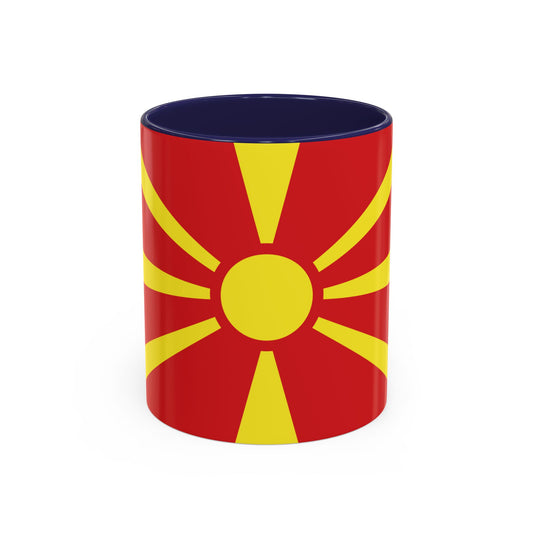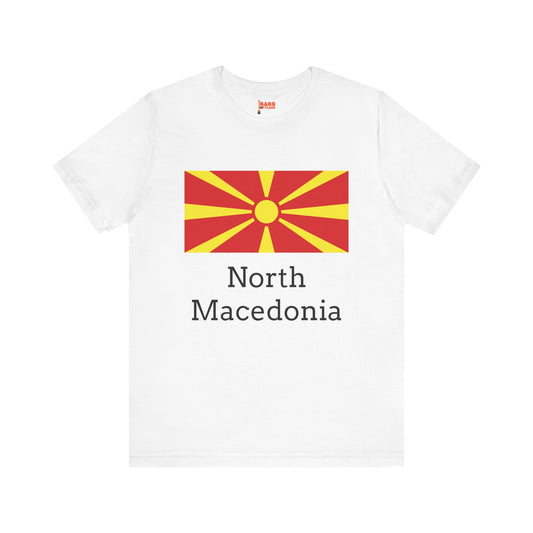-
North Macedonia Sweatshirt
Regular price $34.15 USDRegular priceUnit price / per -
North Macedonia Flag Sweatshirt
Regular price $34.15 USDRegular priceUnit price / per -
North Macedonia Pillow
Regular price $22.65 USDRegular priceUnit price / per -
North Macedonia Backpack
Regular price $59.79 USDRegular priceUnit price / per -
North Macedonia Leather Patch Hat
Regular price $18.85 USDRegular priceUnit price / per -
North Macedonia Mug
Regular price $11.65 USDRegular priceUnit price / per -
North Macedonia Trucker Cap
Regular price $14.90 USDRegular priceUnit price / per -
North Macedonia Flag Hoodies
Regular price $34.40 USDRegular priceUnit price / per -
North Macedonia Hoodies
Regular price $34.40 USDRegular priceUnit price / per -
North Macedonia T-shirts
Regular price $22.79 USDRegular priceUnit price / per -
North Macedonia Flag on T-shirt
Regular price $22.79 USDRegular priceUnit price / per
Collection: North Macedonia
The North Macedonia flag symbolizes national pride and the country's identity. Its distinctive design and colors hold significant historical and cultural importance. We will explore the intriguing facts and controversies surrounding the North Macedonia flag, from its overview to its current relevance in society.
Overview of the North Macedonia Flag

The flag of North Macedonia is instantly recognizable by its striking design: a radiant golden sun centered on a field of deep red. This central motif, the "Sun of Vergina," sends eight bold rays of light stretching across the fabric, reaching the flag's edges. The choice of red for the background amplifies the intensity of the golden sun, creating a visual symbol full of energy and vitality. The color scheme and layout are visually appealing and deeply infused with meaning, reflecting the nation's heritage and people's aspirations for the future. This flag, through its simplicity and powerful imagery, encapsulates the spirit of North Macedonia, serving as a daily reminder of the country's identity and values.
Historical Context of the North Macedonia Flag
The journey to adopting the current flag of North Macedonia is a tale interwoven with the country's quest for sovereignty and recognition on the global stage. In the turbulent years following its declaration of independence from Yugoslavia in 1991, North Macedonia found itself at the center of a heated dispute with Greece over cultural and historical symbols, notably the Sun of Vergina. This ancient emblem, deeply associated with the legacy of Alexander the Great and his father, Philip II of Macedon, was initially featured on the country's first flag post-independence. However, this choice sparked controversy and diplomatic tensions, given Greece's claim over the region of Macedonia and its historical symbols.
The contentious nature of this emblem led to international negotiations, and under pressure, North Macedonia agreed to change its national flag as part of broader efforts to resolve the dispute. This diplomatic and cultural wrangling culminated in the adoption of the current flag design in 1995, which marked a significant compromise and step forward in the nation's international relations. The transition to the new flag symbolized North Macedonia's willingness to forge a distinct national identity while navigating the complexities of regional history and politics. This episode in the flag's history underscores the powerful role symbols play in international relations and the delicate balance countries must strike between national pride and diplomatic pragmatism.
Symbolism Behind the North Macedonia Flag

At the heart of the North Macedonia flag's symbolism is a profound representation of the nation's aspirations and historical journey. The vibrant red background evokes the bravery and sacrifice of those who have fought for the country's freedom and independence as a poignant reminder of the struggles endured throughout its history. Meanwhile, the golden sun, with its eight expansive rays, symbolizes a new dawn for North Macedonia and unity and hope for a prosperous future. Each ray extends toward the flag's edges, suggesting the spread of light, knowledge, and freedom across the nation and beyond its borders. This emblematic sun signifies the country's rich cultural heritage while embracing a vision of progress and inclusivity. Through these symbols, the North Macedonia flag embodies its people's resilience and forward-looking spirit, encapsulating their enduring quest for sovereignty, peace, and unity in a complex and evolving regional landscape.
Current Relevance of the North Macedonia Flag
Today, the North Macedonia flag flies high, symbolizing national unity and pride across a variety of contexts. It plays a central role in public life, marking the presence of the nation at international forums, including the United Nations, and at a host of regional partnerships and events. Within the country, the flag adorns government buildings, schools, and public squares, serving as a constant reminder of the nation's sovereignty and the collective identity of its people. On national holidays such as Independence Day, the flag becomes a focal point of celebrations, with citizens displaying it prominently to express their patriotism and solidarity.
In recent years, the flag has also been at the heart of initiatives aimed at fostering a sense of national cohesion and bridging divides within the society. Educational programs and public campaigns leverage the flag's symbolism to promote values of unity and peace among North Macedonia's diverse communities.
Despite its role in fostering national unity, the flag's historical and cultural significances have occasionally sparked discussions and debates, especially in the context of international relations and identity politics. These dialogues underscore the flag's enduring relevance as not just a national symbol but also a subject of contemporary discourse, reflecting the dynamic and evolving narrative of North Macedonia in the global arena.
Additional Facts About the North Macedonia Flag
When it comes to the ceremonial display and handling of the North Macedonia flag, there are established norms that citizens and organizations are expected to follow to show respect. For instance, the flag must never be allowed to touch the ground, a common practice for national flags worldwide to signify honor and respect. Furthermore, using the flag for commercial purposes is generally frowned upon, preserving its status as a symbol of national integrity and pride rather than a commodity.
Interestingly, while the fundamental design of the flag has remained consistent, minor adjustments have been made since its adoption. These tweaks have primarily involved the precise dimensions and the positioning of the Sun of Vergina to ensure its optimal representation on various mediums and scales. This careful attention to detail underscores the flag's importance as a national emblem and its role in representing North Macedonia both at home and abroad.
Often referred to affectionately as the "Golden Sun" flag, this nickname underscores the central role of the sun motif in embodying the country's aspirations and heritage. The flag’s journey from a symbol of contention to one of unity and progress reflects the nation's resilience and evolving identity, making it a subject of both national pride and fascinating historical study.






















